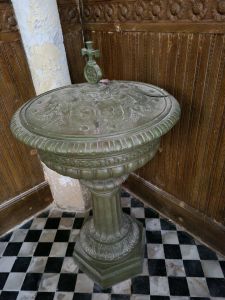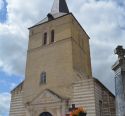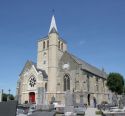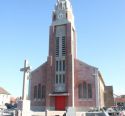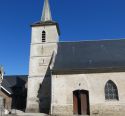Church | XIXe | Neogothic | Catholic Church





Map
Opening hours
01 March - 31 October
Mon
Tue
Wed
Thu
Fri
Sat 10.00 - 17.00
Sun 10.00 - 17.00
01 November - 28 February
Mon
Tue
Wed
Thu
Fri
Sat 10.00 - 16.00
Sun
Currently closed for works. Reopening planned for early June 2025.
Religious offices
Description
Nor is there any mention of a religious building before 1862, when the Delattre-Bernet family built Saint-Joseph church.
Its construction was part of the development and creation of new parishes in the Calais area between 1820 and 1880.
The sober elegance of the red brick building, built on a simple plan, continues inside. Restoration work was recently completed in 2025.
In 1863, the Notre-Dame des Bois chapel was also built in the municipality. Its distinctive brick façade bears the inscription ‘Ave Maria’.
Photos
Remarkable elements
The crozier of Monsignor Evrard
Joseph Alphonse Marie Evrard, een kind van het land, werd op 8 mei 1889 in het dorp geboren. Hij stamde uit de familie Delattre-Bernat, fervente katholieken en notabelen uit de regio. Hij studeerde aan het jezuïetencollege van Boulogne en aan het college Saint-Bertin in Saint-Omer. Al snel voelde hij zich aangetrokken tot het priesterschap en op 21 september 1912 werd hij tot priester gewijd. Daarna ging hij canoniek recht studeren in Rome tot 1914, toen hij werd benoemd tot professor aan het seminarie van Arras.
Na het einde van de oorlog zette hij zijn onderwijs aan het seminarie voort en was hij tegelijkertijd priester in verschillende parochies van het bisdom Arras. Als opmerkelijk pastoor werd hij in 1937 benoemd tot bisschop van Meaux. Omdat hij echter een slechte bestuurder bleek te zijn en ziek werd, nam hij ontslag als bisschop om zich te wijden aan de evangelisatie en dichter bij de realiteit van het veld te staan.
Hij stierf in 1974 in Saint-Omer en werd begraven in Calais.
Zijn familie schonk zijn bisschopsstaf aan de Sint-Jozefkerk in Muncq-Nieurlet.
High Altar
Built at the end of the 19th century in a neo-Gothic style, this high altar stands out from the choir. Recognisable by its pinnacles and tabernacle topped with a turret, the finesse of the marquetry work is highlighted by the polychrome decoration. Six figures surround the tabernacle, with Saint John on its left, recognisable by the chalice he is holding aloft.
Stained glass window
The stained glass window in the choir depicts the Virgin Mary holding her son on her lap and welcoming her cousin Elizabeth and her son, Saint John the Baptist.
Confessional
Made of carved oak at the end of the 19th century, this confessional is also in the neo-Gothic style. This three-compartment model is topped with three gables with hooks and finials.
Woodwork
The choir panelling is made of decorative fibre cement. The carvings feature a large number of symbols of the Resurrection, such as the snail (a snail shell was placed in the coffins of the early Christians), the frog and the lizard (the only animal to enter the chamber of kings as the word of God).







